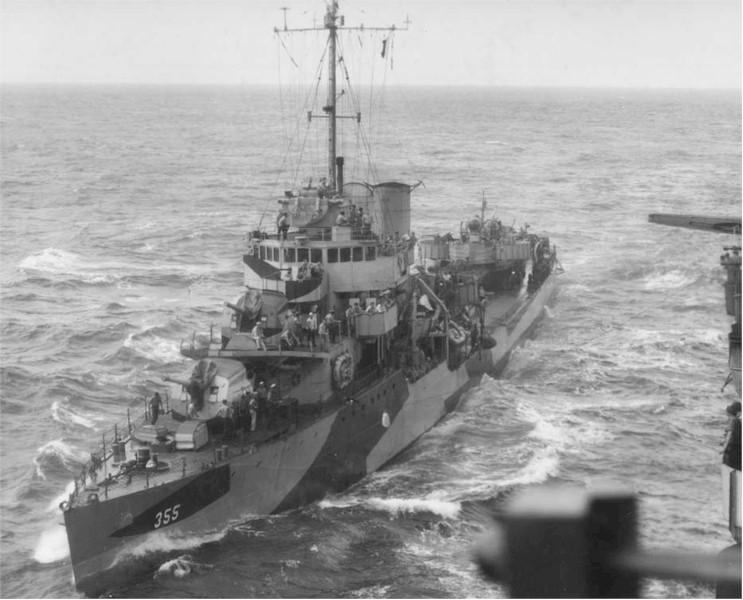

|
|
USS Aylwin (DD 355) found in USS Helena CL-50 War Diary for 19 August 1942,
USS Aylwin (DD-355) was a Farragut-class destroyer, and the third ship of the United States Navy Class and type: Farragut-class destroyer
As Aylwin lay moored in a nest with her squadron mates on the morning of 7 December 1941, one small
Three minutes later, Aylwin returned fire. At 08:00, the "black gang" lit fires under two boilers, cutting them in on
The destroyer, manned by 50% of her crew under the direction of four ensigns-the senior officer, Ensign Stanley
As Aylwin raced out to sea, those men topside who chanced to look astern beheld a curious sight; her captain,
Late on the afternoon of 8 December, Aylwin followed the Enterprise task force into Pearl Harbor and picked
Aylwin sortied as part of the Lexington task force headed to relieve Wake Island on 14 December. Along with the 
to be named for Lieutenant John Cushing Aylwin (1778-1812). Aylwin was laid down on
23 September 1933 by the Philadelphia Navy Yard, launched on 10 July 1934, sponsored by
Miss Elizabeth M. Farley, the 11-year-old daughter of Postmaster General James Farley, and commissioned
on 1 March 1935, with Commander Clarence Gulbranson in command.
Displacement: 1,375 tons
Length: 341 ft 3 in (104.01 m)
Beam: 34 ft 3 in (10.44 m)
Draft: 16 ft 4 in (4.98 m)
Speed: 37 kts (69 km/h)
Range:
6500 nmi at 12 knots
(12,000 km at 22 km/h)
Complement: 251 officers and enlisted
Armament:
As Built:
5 × 5"(127mm)/38cal DP (5x1),
8 × 21 inch (533 mm) T Tubes (2x4),
4 × .50cal (12.7mm) MG AA (4x1)
c1943:
1 × Mk 33 Gun Fire Control System
4 × 5" (127mm)/38cal DP (4x1),
8 × 21" (533 mm) T Tubes (2x4),
5 × Oerlikon 20 mm AA (5x1),
2 × Mk 51 Gun Directors
4 × Bofors 40 mm AA (2x2),
2 × Depth Charge stern racks
boiler was in operation to provide enough power for auxiliary services on board. Approximately half of
her men were enjoying leave and liberty that weekend. At 07:55 that Sunday morning, shortly before morning
colors, the sound of airplane engines surprised Aylwin's men and countless other sailors. At that time,
Japanese planes torpedoed the target ship Utah moored to a quay off Ford Island.
her main steam line within 15 minutes. At 08:29, Commander, Destroyers Battle Force directed his ships to get underway.
At about 08:50, a Japanese plane dropped a bomb that exploded some 75 yards off Aylwin's starboard bow. Eight
minutes later, Aylwin, leaving her stern wire and anchor chain behind, headed for the channel and the open sea.
B. Caplan, had served at sea for only some eight months-proceeded out of Pearl Harbor, stripping ship for war and
simultaneously maintaining a "continuous fire." Her machine gunners claimed to have downed at least three aircraft; but,
in the light of the tremendous volume of antiaircraft fire from all ships, her "kills" cannot be proven conclusively.
Lt. Comdr. Robert H. Rodgers, and other officers, in a motor launch about 1,000 yards off the entrance buoys.
Nevertheless, in view of ComDesRon 1's instructions, Aylwin could not slow down, but instead headed out to
sea for patrol duty, leaving most of her officers orphans on board the old flushdecker Chew. A little less than a
half hour later, Aylwin investigated a reported submarine sighting, but found nothing. During the patrol, the
destroyer vibrated abnormally because of a screw damaged soon after she got underway when a bomb
explosion near her starboard quarter threw her stern into a buoy.
up Rodgers and the division commander, Comdr. R. S. Riggs, on the way into the channel. The next day, Aylwin
got underway and conducted antisubmarine patrols in sector 2, off the entrance to Pearl Harbor. She made a
sound contact on 10 December. After going to general quarters, she dropped a five-charge pattern, but with no
confirmed damage. Entering Pearl Harbor again on the 11th, Aylwin underwent repairs to her damaged propeller.
On 12 December, after the smoke over Oahu had cleared, Comdr. Rodgers heaped praise on his abbreviated
crew for their actions in the first flush of war: "The conduct of the personnel was magnificent.... Every man more
than did his job and was eager to fight." Of Ensign Caplan, Rodgers wrote, "The conduct (of this man) ... in superbly
taking command for 36 hours during war operations of the severest type is a most amazing and outstanding achievement."
heavy cruisers Chicago and Portland and the destroyer Phelps, she took station ahead of Lexington. The next day,
destroyers Dewey and Worden, the cruiser Indianapolis, and the oiler Neosho joined the force.Two Japanese
carriers had joined the forces attacking Wake. This move prompted cancellation of the relief attempt. Wake fell on
23 December. After investigating several suspected submarine contacts en route, Aylwin covered the arrival of TF 11
at Pearl Harbor three days after Christmas. On the last day of 1941, Aylwin sortied from Pearl Harbor in the screen
of a convoy taking evacuees from the Hawaiian Islands to the west coast where she served five days into 1942.